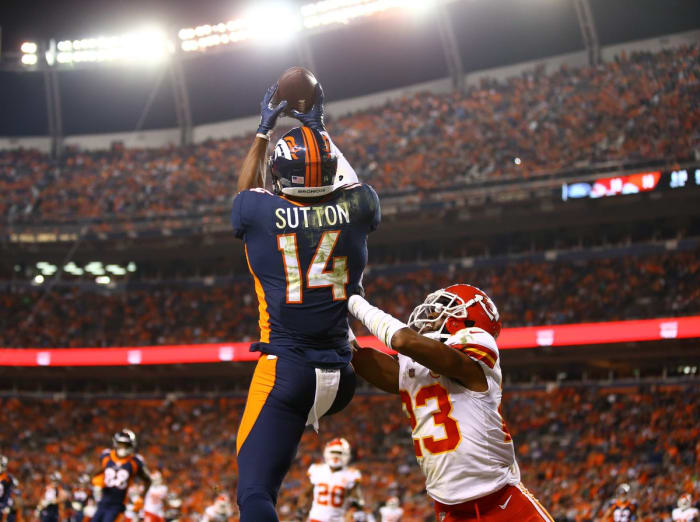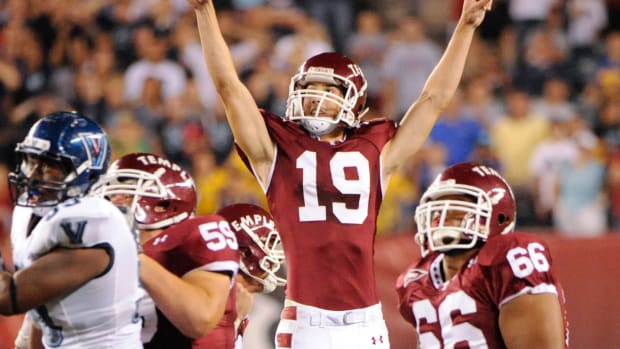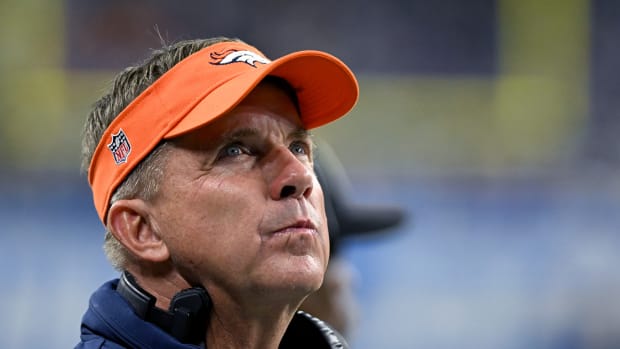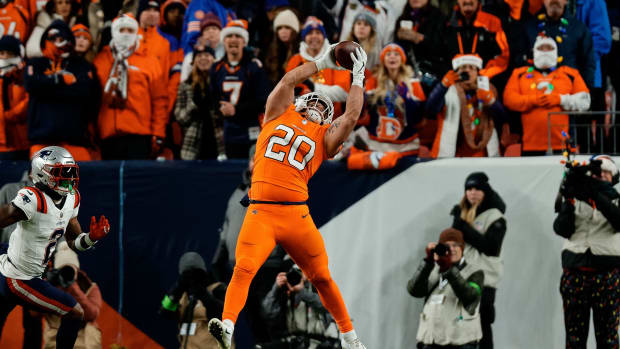3 Keys to a Broncos' Victory Over Chiefs on Sunday Night Football
Six seasons ago, the Denver Broncos hoisted their third Lombardi Trophy after winning Super Bowl 50. But long before the Orange and Blue confetti fell, and Peyton Manning rode off into the sunset, a divisional curse was cast on the Broncos by an unlikely foe.
On November 15, 2015, Manning was benched after throwing four interceptions and getting sacked twice in route to a 29-13 dismantling at the hands of the Kansas City Chiefs. But how was Denver supposed to know that the midseason divisional loss would mark the beginning of an 11-game losing streak to the Chiefs?
It hasn’t been pretty for the Broncos, who have been outscored by an average of 13 points per game against Kansas City. Over the last five seasons, the Broncos have averaged 16 PPG compared to the Chiefs at 29.36.
That was then — and now the 6-5 Broncos are in a three-way tie with the Los Angeles Chargers and Las Vegas Raiders with the 7-4 Chiefs leading the division. It may not feel that the Broncos, who are just one game above .500, are for real, but the potential for an upset on Sunday Night Football is there.
The Broncos have averaged 20.72 PPG this season while allowing 17.81 PPG, compared to the Chiefs who score 25.54 PPG on average and relinquish 22.72 to opponents. Statistics don’t always tell the full scope of the tale but if Denver plans to upset the king of the division, the team has to show up to Arrowhead Stadium ready to rumble.
How do the Broncos snap the streak? Let’s review three keys to a Broncos victory in what amounts to the biggest game since the Super Bowl.
Rush Four & Disguise Coverage
The fundamental question when teams prepare to face a championship quarterback is whether or not to pressure via blitz or fall back in coverage. In last year’s Super Bowl, the Tampa Bay Buccaneers opted out of the pick-your-poison philosophy by abandoning their traditional man coverage scheme and going to a Cover 2 defense against the Chiefs.
Consequently, the Bucs' D-line bruised and battered Chiefs QB Patrick Mahomes, who was sacked three times and hit eight more en route to a 31-9 beatdown. By dropping defensive backs into zone coverage with two safeties over the top, the red-hot Chiefs' offense fizzled out as Mahomes consistently held onto the ball too long, allowing the front four defenders to hit the former MVP.
That was last year, and this season, Kansas City has rebuilt its O-line with younger and better players like rookie center Creed Humphrey and former New England guard Joe Thuney. Against the Chargers, head coach Vic Fangio confused and frustrated second-year QB Justin Herbert, who was forced to throw the ball 44 times, completing 28 throws for 303 yards and two TDs.
But it was rookie cornerback Patrick Surtain II who was in prime position to pick off Herbert twice, including a pick-six that earned him AFC Defensive Player of the Week. Herbert was also sacked three times and was forced to scramble away from pocket pressure with four rushes for just 36 yards.
It might not be an easy assignment to cover Kansas City's dynamic aerial duo Tyreek Hill and Travis Kelce in any matchup, let alone primetime at Arrowhead Stadium, but there’s no reason that the Broncos' D-line — that boasts the likes of Shelby Harris, Dre’Mont Jones, and McTelvin Agim (who logged a sack and two QB hits last week) —shouldn’t be able to generate internal pressure on Mahomes.
By constricting the pocket with edge rushers like Bradley Chubb, Jonathon Cooper, Malik Reed, and Stephen Weatherly, the Broncos will allow their defensive backs time to recover from the dynamic nature of Kansas City's offense. It’s okay to blitz Mahomes but do it sparingly and be ready to bail out of the original pre-snap coverage.
By utilizing shell coverage with designated sides of the field set up in zone, Fangio could also implement an umbrella-style coverage that funnels most of the open space towards the middle of the field, rather than the deep attack that has plagued Denver for half a decade.
Feed the Wideout Trio
If the Broncos realistically hope to trade blows with the Chiefs on offense, it cannot strictly be through the rushing attack. At some point in this game, it's very probable that Denver will trail, and when this happens, OC Pat Shurmur has repeatedly shown a penchant for abandoning the run to go three-wide in a spread passing attack.
Don’t’ get me wrong, I’d love to see rookie RB Javonte Williams get the ball 20 times, but the fact of the matter is, Fangio has only won a single game when trailing at half-time. Short passes will be key for Shurmur’s offense which matches Teddy Bridgewater's preferences.
Bridgewater has been an above-average quarterback in completion percentage against the blitz this season. Heck, the man has a 3-to-1 touchdown-to-interception ratio and has a higher passing rating, completion percentage, and yards per attempt than Mahomes. Teddy has also thrown fewer interceptions than Mahomes.
He's not the answer or franchise QB of the future, but Bridgewater is the most qualified and successful Broncos' signal-caller to march into Arrowhead since No. 18. Quick slant routes underneath should be the bread and butter for second-year wideout Jerry Jeudy, who seems to be fully recovered from the ankle injury that sidelined him for seven games earlier this season.
Since returning to the starting lineup, Jeudy has been targeted 24 times, logging 18 receptions for 181 yards. Expect his utilization in the slot to be maximized for immediate relief as Bridgewater will be blitzed and pressured by Chiefs' DC Steve Spagnuolo’s defense. Then again, the good guys won’t be going against world-beaters in the secondary other than Kansas City's safety duo Tyrann Mathieu and Juan Thornhill.
Courtland Sutton and Tim Patrick, who were both recently inked to a contract extension, need to be game-changers for Bridgewater and company. Patrick currently leads the receiving corps with four touchdowns and has been a consistent blocker on the perimeter and a safety net for a bewildered offense still struggling to form an identity.
Meanwhile, Sutton has consistently snatched 50/50 balls by using his size and vertical jump to beat corners and safeties alike. In addition to the quick passes, it’d behoove the Broncos' offense to sprinkle in some receiver screens and deep bombs if presented with man-to-man coverage.
It takes time to get a return on investment, but right now, the Broncos have to find a way to snap this massive losing streak. It starts with core players like Sutton, Patrick, and Jeudy, whom GM George Paton has identified as pillars of the franchise.
Street Fight KC's Most Dominant Defender
Chiefs' defensive end Chris Jones may have been a second-round pick in 2016, but the 6-foot-6, 310-pound trenchman has been an absolute nightmare for opposing O-linemen. The former Mississippi State Bulldog has logged eight tackles and seven sacks after originally moving from an outside technique to inside, creating havoc at the line of scrimmage.
Film study consistently shows Jones’ high motor and low pad level which allows him to fight double teams and be just as aggressive in the run game as he is as a pass rusher. The 27-year-old Pro Bowler and All-Pro has been credited with 12 stops, 28 hurries, and 41 total pressures for the Chiefs.
It’s no secret that Broncos' second-year center Lloyd Cushenberry continues to struggle at the point of attack with strong, explosive defenders like Jones. Rookie right guard Quinn Meinerz has been more than a feel-good story as a former Division III standout and has been a road-grader in the Broncos' run game.
Left guard Dalton Risner exited last week’s game with a back injury and is questionable to play on SNF. For the sake of argument, if Risner cannot play Sunday night, Netane Muti would fill the void, leaving the Broncos' interior O-line extremely youthful and inexperienced.
But in a street fight, how much does technique really matter? Despite the interior O-line's struggles in pass protection, Denver's run blocking has been nothing short of nasty. That’s not to say that the discipline and fundamentals of pass pro should be ignored but darn it, Denver should not be bullied by Jones upfront.
In years past, the Broncos' O-line has completely fallen apart and has been anything but mentally or physically tough. But this group seems to have grit, pride, and a stubborn unwillingness to submit to its opponent.
If Denver hopes to have a chance of success, let alone respect, it’ll be critical to show up ready to fight (within the rules) against Kansas City’s nastiest defender. Double teams, traps, and wham blocks can only go so far in terms of strategy.
If Broncos lose on Sunday, it will be the largest losing streak to an opponent since the Raiders bullied Denver in the 1960s in what finished as a 14-game skid.
Follow Luke on Twitter @LukePattersonLP.
Follow Mile High Huddle on Twitter and Facebook.
Subscribe to Mile High Huddle on YouTube for daily Broncos live-stream podcasts!







